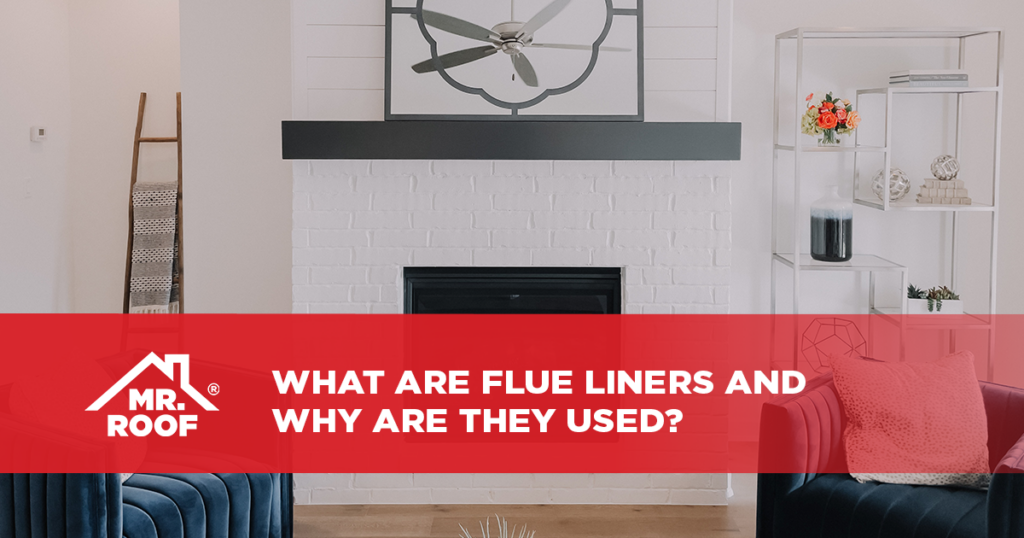Flue liners have an important role to play in ensuring the long life and safe use of your chimney. Flue liners are a conduit inside a chimney made from either clay, ceramic, or metal materials. If your home has a chimney, you likely already have a flue liner. However, if you don’t, you may experience several complications when it comes to the quality of your chimney and its ability to perform long-term. Flue liners help to keep your home cozy and comfortable, making them valuable assets.
Chimney and fireplace flues also add value to your home if you ever intend to sell. Most potential buyers are willing to pay more for a home that has a flue versus one without. Flues are a necessity if you heat your home with propane or natural gas. Your liner is created to ensure you stay warm without the fear of causing an unintended fire or carbon monoxide leak entering your home.
The main purpose of your chimney is to vent combustion products into the outdoors. Without a functioning and safe flue for your fireplace, soot, fumes, and harmful byproducts like creosote, which is created from burning wood, can circulate throughout your home, potentially threatening the health and well-being of the pets and humans inside. With no moving parts and little maintenance, flue liners are a worthwhile investment that can last for decades.
What is a flue liner?
A flue liner is located inside your chimney. It is a vertical passageway that transports waste gas outside. It is essentially an exhaust pipe that carries any harmful gases or debris safely outdoors. Heat rises, which is why your upstairs always feels warmer than the lower floors. The same can be said for your chimney. Hot, buoyant gases travel up to the top and exit out of the chimney flue cap. Without drawing the combustion air out, trying to start a fire would be impossible. Your home, chimney, and flue liner all work together to provide the combustion air you need to maintain a fire while also venting any potential harmful byproducts out.
Types of flue liners
There are three main types of flue liners commonly installed within a home. Each option comes with a variety of pros and cons. If you are looking to install a liner for the first time or your liner needs a replacement, a professional installer can help you determine which option is best for you. Deciding on which liner is best often depends on your budget, heating use, and other specifications that can vary depending on your unique situation.
Clay flue liners
Clay flue liners tend to be the most common type throughout different households, especially homes that are older. Brick chimneys often rely on clay flue tiles to make up their flue liner system. These tiles are made of terra-cotta, which is an affordable and durable material. Clay flue liners can withstand decades of corrosive cases and byproducts, such as creosote, without a serious risk of deterioration. The biggest problems clay flue liners can experience are exposure to water and the risk of a chimney fire.
When exposed to moisture, the corrosive residue within the flue liner can mix and create a type of acid that will deteriorate the clay tiles as well as mortar joints within. This can affect the functionality of your liner and the masonry work of the chimney itself. To prevent any risks from water, it is important to have a chimney cap. This cap forces water away from the opening of your chimney as well as continues to allow gases to escape. Fire can also be a risk, especially with heavy buildup inside of the liner. To protect your home and your family’s safety, it is important that your chimney is properly inspected and maintained on a regular basis.
Cast-in-place liners
As the name suggests, this type of liner is formed by pouring a concrete-like material against the interior walls of the chimney and left to harden. This creates a smooth, solid liner with no cracks or leaks. This option provides ideal insulation and can even improve the structural integrity of the chimney. This liner is also popular because it can resist higher temperatures than other liner options. It is made to withstand up to 2,100 degrees with ease. When deciding if a cast-in-place liner is right for you, it is important to note that this is a permanent liner. This means that if any damage were to occur, such as a crack or leak, you would likely need to replace the entire liner. While this rarely happens, it is still important to consider.
Metal flue liners
When it comes to the top choice for flue liners today, metal liners easily take the lead. Metal flue liners are a great option for adding or replacing an outdated liner. Metal has extremely high corrosion resistance. It can also be custom designed for any kind of chimney, making it a popular choice for modern homes. It can be flexible or rigid in structure. Metal flue liners are affordable and easy to install, which can save you more money.
Metal liners, also referred to as flue liner kits, are ideal for damaged flue pipes. A damaged flue could lead to serious blockages or gaps that could allow carbon monoxide and other harmful byproducts to enter your home. When replacement is necessary, metal liners can make the job easier, with results that can last just as long. Metal flue liners are often made with either aluminum, which is mainly used for natural gas fuels, or stainless steel. Metal lines can perform the same, if not better, than the original clay lining.
Main functions of a flue liner
One of the main functions of a flue liner is to protect against accidental fires. Chimneys are composed of materials that are meant to withstand extreme heat and corrosive gases. However, your chimney also sits right against the rest of your home. This means that any support structures or combustible framing could prove a potential fire risk due to heat transfer. The most important role of a flue liner is to limit heat transfer. This allows you to enjoy the use of your fireplace as often as you would like without having to fear that elements outside of your chimney are at risk of catching on fire.
Protection against damage to the masonry is another function of the flue liner. While bricks, in general, tend to be durable and long-lasting, the mortar holding the bricks together is not always as reliable. Over time, corrosive materials can eat away at mortar joints, which ultimately support your brickwork. A breakdown of mortar joints could affect the heat transfer capabilities of your liner, which could lead to rapid heat transfer and the risk of fire or harmful byproducts getting into your air. A quality flue liner is another line of protection in keeping you safe and preserving the long life of the structure of your fireplace and chimney.
Flue liners also help to maximize efficiency. With any system in your home, you want it to operate as efficiently as possible. This ensures that your system is working at its fullest capability.
Importance of regular maintenance
No matter what type of flue liner you have, or if you need one installed, it is beneficial to have your liner inspected and cleaned at least once a year. This helps to ensure that there are no cracks or damage that could be causing harmful byproducts to get back into your air. Having your chimney professionally cleaned can help prevent blockage. Blockages can be created by nesting materials left behind by animals, or debris from trees, such as leaves and small branches, getting past your chimney cap. A blockage can also be caused by a buildup of corrosive material such as creosote.
It is beneficial to contact a professional if you notice these signs:
- Water leakage or damage around the structure of the chimney
- Smell of smoke that doesn’t dissipate over time
- White residue on liner walls
- Debris such as soot, dust, and dirt falling towards the back of the fireplace
Your chimney and fireplace are important aspects of your home. They create a welcoming atmosphere and provide a reliable heating source. A flue liner is designed to ensure you are able to continue enjoying the use of your fireplace year after year. It regulates heat transfer, protects the masonry, and provides peace of mind that you are caring for your system. Flue liners require minimum maintenance to keep them performing at their best for years to come. Flue liners are available in clay, metal, and concrete-like materials to meet the needs of your home. A professional installer can walk you through all your available options to help determine which flue liner is right for you, considering all your needs. Most installation companies also offer flue liner maintenance services when you need them. These services keep your fireplace operating at its best, saving you both time and money. For a free estimate, Contact Mr. Roof, your local professional, today.









